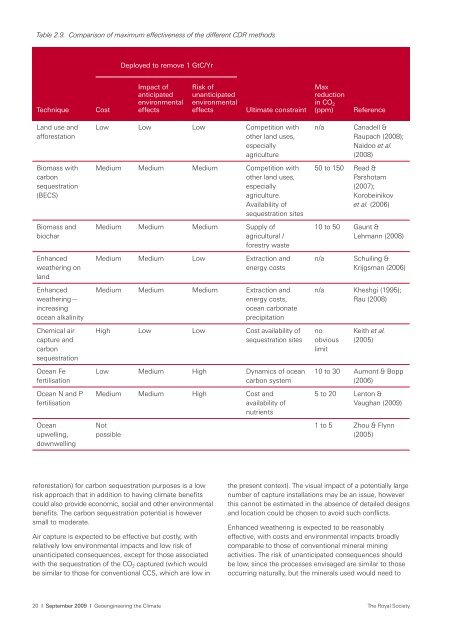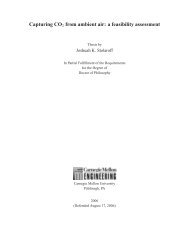Royal Society - David Keith
Royal Society - David Keith
Royal Society - David Keith
Create successful ePaper yourself
Turn your PDF publications into a flip-book with our unique Google optimized e-Paper software.
Table 2.9. Comparison of maximum effectiveness of the different CDR methods<br />
Deployed to remove 1 GtC/Yr<br />
Technique<br />
Cost<br />
Impact of<br />
anticipated<br />
environmental<br />
effects<br />
Risk of<br />
unanticipated<br />
environmental<br />
effects<br />
Ultimate constraint<br />
Max<br />
reduction<br />
in CO 2<br />
(ppm)<br />
Reference<br />
Land use and<br />
afforestation<br />
Biomass with<br />
carbon<br />
sequestration<br />
(BECS)<br />
Biomass and<br />
biochar<br />
Enhanced<br />
weathering on<br />
land<br />
Enhanced<br />
weathering—<br />
increasing<br />
ocean alkalinity<br />
Chemical air<br />
capture and<br />
carbon<br />
sequestration<br />
Ocean Fe<br />
fertilisation<br />
Ocean N and P<br />
fertilisation<br />
Ocean<br />
upwelling,<br />
downwelling<br />
Low Low Low Competition with<br />
other land uses,<br />
especially<br />
agriculture<br />
Medium Medium Medium Competition with<br />
other land uses,<br />
especially<br />
agriculture.<br />
Availability of<br />
sequestration sites<br />
Medium Medium Medium Supply of<br />
agricultural /<br />
forestry waste<br />
Medium Medium Low Extraction and<br />
energy costs<br />
Medium Medium Medium Extraction and<br />
energy costs,<br />
ocean carbonate<br />
precipitation<br />
High Low Low Cost availability of<br />
sequestration sites<br />
Low Medium High Dynamics of ocean<br />
carbon system<br />
Medium Medium High Cost and<br />
availability of<br />
nutrients<br />
Not<br />
possible<br />
n/a<br />
Canadell &<br />
Raupach (2008);<br />
Naidoo et al.<br />
(2008)<br />
50 to 150 Read &<br />
Parshotam<br />
(2007);<br />
Korobeinikov<br />
et al. (2006)<br />
10 to 50 Gaunt &<br />
Lehmann (2008)<br />
n/a<br />
Schuiling &<br />
Krijgsman (2006)<br />
n/a Kheshgi (1995);<br />
Rau (2008)<br />
no<br />
obvious<br />
limit<br />
<strong>Keith</strong> et al.<br />
(2005)<br />
10 to 30 Aumont & Bopp<br />
(2006)<br />
5 to 20 Lenton &<br />
Vaughan (2009)<br />
1 to 5 Zhou & Flynn<br />
(2005)<br />
reforestation) for carbon sequestration purposes is a low<br />
risk approach that in addition to having climate benefits<br />
could also provide economic, social and other environmental<br />
benefits. The carbon sequestration potential is however<br />
small to moderate.<br />
Air capture is expected to be effective but costly, with<br />
relatively low environmental impacts and low risk of<br />
unanticipated consequences, except for those associated<br />
with the sequestration of the CO 2 captured (which would<br />
be similar to those for conventional CCS, which are low in<br />
the present context). The visual impact of a potentially large<br />
number of capture installations may be an issue, however<br />
this cannot be estimated in the absence of detailed designs<br />
and location could be chosen to avoid such conflicts.<br />
Enhanced weathering is expected to be reasonably<br />
effective, with costs and environmental impacts broadly<br />
comparable to those of conventional mineral mining<br />
activities. The risk of unanticipated consequences should<br />
be low, since the processes envisaged are similar to those<br />
occurring naturally, but the minerals used would need to<br />
20 I September 2009 I Geoengineering the Climate The <strong>Royal</strong> <strong>Society</strong>








